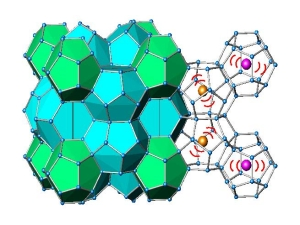Clathrates
| Intermetallic clathrates are solids made up of a three-dimensional network of covalently bonded „host“ atoms
forming large cavities. These are filled by mostly non-covalently bonded „guest“ atoms. The current interest in these cage compounds
derives mainly from their potential as thermoelectric materials: The vibrations („rattling“) of the losely bound guest atoms within
the oversized cages are believed to strongly scatter heat-carrying phonons, thereby reducing the phonon thermal conductivity of the material.
The charge carriers are much less affected by the rattling modes than the heat carriers, thus leading to an enhanced ratio of electrical
to thermal conductivity σ/κ. This enhances the thermo-electric figure of merit
Z = (σ/κ)S2 where S is the thermopower. In order to obtain Z values relevant for applications, the thermopower must in addition be maximized. One promising route is to incorporate strong correlation effects into clathrates. In the so-called Kondo insulators the hybridization of f-derived states with a broad conduction band leads to giant values of the thermopower. So far the incorporation of the rare earth element Eu as guest atom in clathrates of different compositions has been accomplished by several groups worldwide. The interaction of the Eu 4f state in these compounds is, however, too weak to lead to Kondo-insulating behaviour. Our current research focusses on the modification of the composition of Eu containing clathrates as well as on the search for clathrates containing other rare earth elements. Collaborations: MPI CPfS Dresden, Uni Wien |
Structure of type-I clathrate
Fig.2: Schematic representation of rattling guest atoms in oversized cages made up of host atoms in a type-I clathrate [after: Paschen et al., Phys. Rev. B 64 (2001) 214404] |
Contact: E. Bauer, S. Bühler-Paschen |


